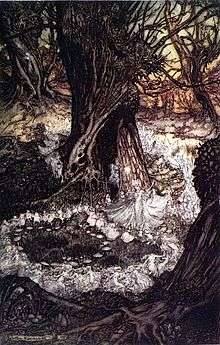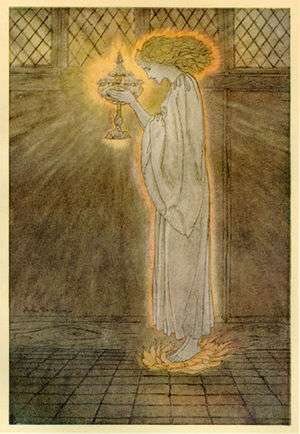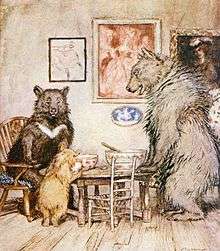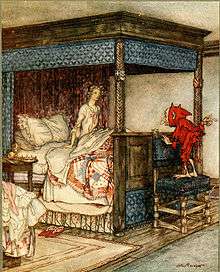Arthur Rackham
| Arthur Rackham | |
|---|---|
 | |
| Born |
19 September 1867 Lewisham, Kent, England |
| Died |
6 September 1939 (aged 71) Limpsfield, Surrey, England |
| Nationality | English |
| Known for | Children's literature, Illustration |

Arthur Rackham (19 September 1867 – 6 September 1939) was an English book illustrator.
Biography
Rackham was born in Lewisham, then still part of Kent as one of 12 children. In 1884, at the age of 17, he was sent on an ocean voyage to Australia to improve his fragile health, accompanied by two aunts.[1] At the age of 18, he worked as a clerk at the Westminster Fire Office and began studying part-time at the Lambeth School of Art.[2]
In 1892, he left his job and started working for the Westminster Budget as a reporter and illustrator. His first book illustrations were published in 1893 in To the Other Side by Thomas Rhodes, but his first serious commission was in 1894 for The Dolly Dialogues, the collected sketches of Anthony Hope, who later went on to write The Prisoner of Zenda. Book illustrating then became Rackham's career for the rest of his life.
By the turn of the century Rackham had developed a reputation for pen and ink fantasy illustration with richly illustrated gift books such as The Ingoldsby Legends (1898), Gulliver's Travels and Fairy Tales of the Brothers Grimm (both 1900). This was developed further through the austere years of the Boer War with regular contributions to children's periodicals such as Little Folks and Cassell's Magazine. In 1901 he moved to Wychcombe Studios near Haverstock Hill, and in 1903 married his neighbour Edyth Starkie.[3] Edith suffered a miscarriage in 1904, but the couple had one daughter, Barbara, in 1908. Although acknowledged as an accomplished black-and-white book illustrator for some years, it was the publication of his full colour plates to Washington Irving's Rip Van Winkle by Heinemann in 1905 that particularly brought him into public attention, his reputation being confirmed the following year with J.M.Barrie's Peter Pan in Kensington Gardens, published by Hodder & Stoughton. Income from the books was greatly augmented by annual exhibitions of the artwork at the Leicester Galleries. Rackham won a gold medal at the Milan International Exhibition in 1906 and another one at the Barcelona International Exposition in 1912. His works were included in numerous exhibitions, including one at the Louvre in Paris in 1914.
From 1906 the family lived in Chalcot Gardens, near Haverstock Hill,[4] until moving from London to Houghton, West Sussex in 1920. In 1929 the family settled into a newly built property in Limpsfield, Surrey.[5] Arthur Rackham died in 1939 of cancer at his home.
Significance

Arthur Rackham is widely regarded as one of the leading illustrators from the 'Golden Age' of British book illustration which roughly encompassed the years from 1890 until the end of the First World War. During that period, there was a strong market for high quality illustrated books which typically were given as Christmas gifts. Many of Rackham's books were produced in a de luxe limited edition, often vellum bound and sometimes signed, as well as a larger, less ornately bound quarto 'trade' edition. This was often followed by a more modestly presented octavo edition in subsequent years for particularly popular books. The onset of the war in 1914 curtailed the market for such quality books, and the public's taste for fantasy and fairies also declined in the 1920s.
Arthur Rackham's works have become very popular since his death, both in North America and Britain. His images have been widely used by the greeting card industry and many of his books are still in print or have been recently available in both paperback and hardback editions. His original drawings and paintings are keenly sought at the major international art auction houses.
Technique

Rackham's illustrations were chiefly based on robust pen and India ink drawings. Rackham gradually perfected his own uniquely expressive line from his background in journalistic illustration, paired with subtle use of watercolour, a technique which he was able to exploit due to technological developments in photographic reproduction. He would first lightly block in shapes and details of the drawing with a soft pencil, for the more elaborate colour plates often utilising one of a small selection of compositional devices.[6] Over this he would then carefully work in lines of pen and India ink, removing the pencil traces after the drawing had begun to take form. For colour pictures, he would begin painting by building up multiple thin washes of watercolour creating translucent tints. One of the disadvantages of the 3-colour (later 4-colour) printing process in the early years was that definition could be lost in the final print, Rackham would sometimes compensate for this by over-inking his drawings once more after painting.[7] He would also go on to expand the use of silhouette cuts in illustration work, particularly in the period after the First World War, as exemplified by his Sleeping Beauty and Cinderella.[8]
Typically, Rackham contributed both colour and monotone illustrations towards the works incorporating his images – and in the case of Hawthorne's Wonder Book, he also provided a number of part-coloured block images similar in style to Meiji era Japanese woodblocks.
Rackham's work is often described as a fusion of a northern European 'Nordic' style strongly influenced by the Japanese woodblock tradition of the early 19th century.
Notable works
.png)

- The Zankiwank and the Bletherwitch by Shafto Justin Adair Fitzgerald (40 line, 1896)
- Two Old Ladies, Two Foolish Fairies, and a Tom Cat by Maggie Browne (pseud. Margaret Hamer) (4 colour plates, 19 line, 1897)
- Feats on the Fjord by Harriet Martineau (f/p colour, 11 line, 1899) Project Gutenberg
- The Greek Heroes by Barthold Georg Niebuhr (4 colour plates, 8 line, 1903)
- Rip van Winkle by Washington Irving (51 colour plates, 3 line, 1905)
- Puck of Pook's Hill by Rudyard Kipling (4 colour plates, 1906 USA release only)
- Peter Pan in Kensington Gardens by J.M. Barrie (49 colour plates, 1906)
- Alice's Adventures in Wonderland by Lewis Carroll (13 colour plates, 15 line, 1907)
- The Ingoldsby Legends by Thomas Ingoldsby (pseud. Richard Harris Barham) (12 colour, 80 line 1898, reworked edition 23 colour plates, 73 line, 1907)
- A Midsummer Night's Dream by William Shakespeare (40 colour plates, 34 line, 1908)
- Tales from Shakespeare by Charles and Mary Lamb (colour F/P, 11 line 1899, reworked edition 12 colour plates, 37 line, 1909)
- Fairy Tales of the Brothers Grimm (95 line, 1900, reworked edition 40 colour plates, 62 line, 1909)
- Gulliver's Travels by Jonathan Swift (Colour F/P, 11 line 1900, reworked edition 12 colour plates, 34 line, 1909)
- Undine by Friedrich de la Motte Fouqué (15 colour plates, 41 line, 1909)
- The Rhinegold and The Valkyrie by Richard Wagner (34 colour plates, 8 line, 1910)
- Siegfried and The Twilight of the Gods by Richard Wagner (32 colour plates, 8 line, 1911)
- Aesop's Fables by Aesop (13 colour plates, 82 line, 1912)
- Mother Goose: The Old Nursery Rhymes (13 colour plates, mostly reprinted from St.Nicholas magazine, 78 line, 1913)
- A Christmas Carol by Charles Dickens (12 colour plates, 1915)
- The Allies Fairy Book (12 colour plates, 23 line 1916)
- Little Brother and Little Sister by The Brothers Grimm (13 colour plates, 45 line, 1917)
- The Romance of King Arthur and His Knights of the Round Table by Alfred W. Pollard (23 colour and monotone plates, 16 line, 1917)
- English Fairy Tales by Flora Annie Steel (16 colour plates, 43 line, 1918)
- The Springtide of Life by Algernon Charles Swinburne (8 colour plates, 1918)
- Some British Ballads (16 colour plates, 23 line, 1918)
- Cinderella ed. Charles S. Evans (1 colour plate, 60 silhouettes, 1919)
- The Sleeping Beauty ed. Charles S. Evans (1 colour plate, 65 silhouettes, 1920)
- Irish Fairy Tales by James Stephens (16 colour plates, 20 line, 1920)
- Comus by John Milton (22 colour plates, 35 line, 1922)
- A Wonder-Book for Girls and Boys by Nathaniel Hawthorne (16 colour plates, 21 line, 1922)
- Poor Cecco by Margery Williams (7 colour plates, 12 line, 1925)
- The Tempest by William Shakespeare (20 colour plates, 20 line, 1926)
- The Legend of Sleepy Hollow by Washington Irving (8 colour plates, 32 line, 1928)
- The Vicar of Wakefield by Oliver Goldsmith (12 colour plates, 23 line, 1929)
- The Compleat Angler by Izaak Walton (12 colour plates, 22 line, 1931)
- The King of the Golden River by John Ruskin (4 colour plates, 13 line, T/P 2 colour, 1932)
- Fairy Tales by Hans Christian Andersen (12 colour plates, 43 line, 9 silhouettes 1932)
- Goblin Market by Christina Rossetti (4 colour plates, 19 line, E/P, 1933)
- The Pied Piper of Hamelin by Robert Browning (4 colour plates, 15 line, 1 silhouette, E/P, 1934)
- Tales of Mystery & Imagination by Edgar Allan Poe (12 colour plates, 28 line, 1935)
- Peer Gynt by Henrik Ibsen (12 colour plates, 38 line, 1936)
- The Wind in the Willows by Kenneth Grahame (16 colour plates, posthumously 1940 US, 1950 UK)
Gallery
-

"Fee-fi-fo-fum, I smell the blood of an Englishman", illustration to a 1918 English Fairy Tales, by Flora Annie Steel
-

"How at the Castle of Corbin a Maiden Bare in the Sangreal and Foretold the Achievements of Galahad", from The Romance of King Arthur and His Knights of the Round Table, by Alfred W. Pollard, 1917
-

"The giant Galligantua and the wicked old magician transform the duke's daughter into a white hind", illustration to English Fairy Tales, by Flora Annie Steel
-

"The giant Cormoran was the terror of all the country-side", illustration to English Fairy Tales, by Flora Annie Steel
-

"The Three Bears", illustration to English Fairy Tales, by Flora Annie Steel
-

"Siegfried leaving Brünnhilde", illustration to Richard Wagner's The Ring
-

"The Rhinemaidens warn Siegfried", illustration to Richard Wagner's The Ring
-
.jpg)
"The Rhinemaidens try to reclaim their gold", illustration to Richard Wagner's The Ring
-

"The Twa Corbies", illustration to Some British Ballads
-

"One day they were overheard by a fairy", illustration of Maimie and Tony in Peter Pan in Kensington Gardens
-

Arthur Rackham The Valiant Little Tailor
-

"‘O waken, waken, Burd Isbel", from Young Beichan, Child ballad number 53
Influence
In one of the featurettes on the DVD of Pan's Labyrinth, and in the commentary track for Hellboy, director Guillermo del Toro cites Rackham as an influence on the design of "The Faun" of Pan's Labyrinth. He liked the dark tone of Rackham's gritty realistic drawings and had decided to incorporate this into the film. In Hellboy, the design of the tree growing out of the altar in the ruined abbey off the coast of Scotland where Hellboy was brought over, is actually referred to as a "Rackham tree" by the director.
References
- ↑ Hudson, Derek, Arthur Rackham: His Life and Work, Heinemann London 1960
- ↑ Silvey, 373
- ↑ James Hamilton - Arthur Rackham, A Biography, Arcade Publishing NY 1990. p.65
- ↑ Hamilton p.79
- ↑ Hamilton p.119
- ↑ Gettings, Fred: Arthur Rackham (Studio Vista 1975, p.55-76)
- ↑ Gettings p.51
- ↑ Arousing Delight, Arthur Rackham
External links
| Wikimedia Commons has media related to Arthur Rackham. |
| Wikisource has original works written by or about: Arthur Rackham |
- Works by Arthur Rackham at Project Gutenberg
- Works by or about Arthur Rackham at Internet Archive
- Little brother & little sister and other tales by the Brothers Grimm illustrated by Arthur Rackham, 1917
- Arthur Rackham and his art
- Biography Online Gallery Ephemea freely downloadable at Fairyworx,Part of the Golden Age of Illustrators Collection
- Arthur Rackham's illustrations for Fairy Tales, Myths and Legends
- Innovated Life Art Gallery: Select illustrations by Arthur Rackham, biography and contemporary reviews
- Alice's Adventures in Wonderland, illustrated by Arthur Rackham
- Arthur Rackham art at Art Passions (free online gallery)
- SurLaLune Fairy Tale Pages: Fairy Tale Illustrations of Arthur Rackham
- Arthur Rackham artwork at American Art Archives web site
- Complete Arthur Rackham Collection for 'The Ring of the Nibelung'
- Information about Arthur Rackham and his art